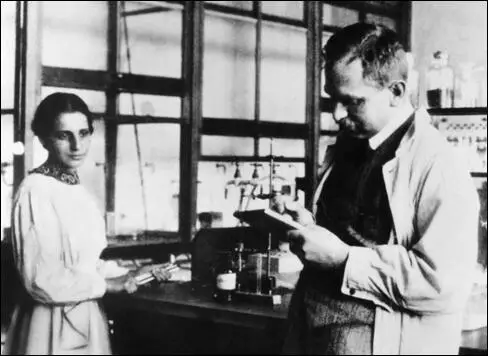Lise Meitner

Lise Meitner was born into a Jewish family in Vienna, Austria, on 7th November, 1878. She studied science at the University of Vienna before moving to Berlin where she joined with Otto Hahn in researching radioactivity at the Kaiser Wilhelm Institute for Chemistry. However, she was refused permission to work in the laboratory because she was a woman.
The First World War brought changes in attitudes towards women scientists and in 1917 m was appointed as head of the Physics Department in the institute. The following year Meitner and Otto Hahn discovered protactinium.
Meitner was appointed professor at the Berlin Institute of Theoretical Physics in 1926 and carried out important investigations into the products of neutron bombardment of uranium.
Meitner and Otto Hahn were now joined by Fritz Strassmann and discovered that uranium nuclei split when bombarded with neutrons.

Meitner, like other Jews in Germany, was dismissed from her university post in 1938. She moved to Sweden and in 1939 wrote a paper with Otto Frisch explaining the theory of uranium fission. In the paper they argued that by splitting the atom it was possible to use a few pounds of uranium to create the explosive and destructive power of many thousands of pounds of dynamite. However, unlike other scientists working in this field, Meitner refused to go the United States and work on the Manhattan Project that was attempting to produce the atomic bomb.
After the Second World War Meitner continued to study the nature of fission products. Her later research concerned the production of new radioactive species using the cyclotron.
Lise Meitner died in Cambridge, England, on 27th October, 1968.
Primary Sources
(1) Lise Meitner and Otto Frisch, Uranium Fission (1938)
From chemical evidence, Hahn and Strassmann conclude that radioactive barium nuclei (atom number Z = 56) are produced when uranium (Z = 92) is bombarded by neutrons. it has been pointed out that this might be explained as a result of a "fission" of the uranium nucleus, similar to the division of a droplet into two. The energy liberated in such processes was estimated to be about 200 Mev, both from mass defect considerations and from the repulsion of the two nuclei resulting from the "fission" process.
If this picture is correct, one would expect fast-moving nuclei of atomic number 40 to 50 and atomic weight 100 to 150, and up to 100 Mev energy, to emerge from a layer of uranium bombarded with neutrons. In spite of their high energy, these nuclei should have a range in air of a few millimeters only, on account of their high effective charge (estimated to be about 20), which implies very dense ionization. Each such particle should produce a total of about 3 million ion pairs.
By means of a uranium-lined ionization chamber, connected to a linear amplifier, I have succeeded in demonstrating the occurrence of such bursts of ionization. The amplifier was connected to a thyratron which was biased so as to count only pulses corresponding to at least 5 x 105 ion pairs. About 15 particles per minute were recorded when 300 milligram of radium, mixed with beryllium, was placed one centimeter from the uranium lining. No pulses at all were recorded during repeated check runs of several hours total duration when either the neutron source or the uranium lining was removed. With the neutron source at a distance of four centimeters from the uranium lining, surrounding the source with paraffin wax enhanced the effect by a factor of two.
It was checked that the number of pulses depended linearly on the strength of the neutron source; this was done in order to exclude the possibility that the pulses are produced by accidental summation of smaller pulses. When the amplifier was connected to an oscillograph, the large pulses could be seen very distinctly on the background of much smaller pulses due to the alpha particles of uranium.
By varying the bias of the thyratron, the maximum size of pulses was found to correspond to at least 2 million ion pairs, or an energy loss of 70 Mev of the particle within the chamber. Since the longest path of a particle in the chamber was 3 centimeters, and the chamber was filled with hydrogen at atmospheric pressure, the particles must ionize so heavily that they can make 2 million ion pairs on a path equivalent to 0.8 cm of air or less. From this it can be estimated that the ionizing particles must have an atomic weight of at least about seventy, assuming a reasonable connection between atomic weight and effective charge. This seems to be conclusive physical evidence for the breaking up of uranium nuclei into parts of comparable size, as indicated by the experiments of Hahn and Strassmann.
Experiments with thorium instead of uranium gave quite similar results, except that surrounding the neutron source with paraffin did not enhance, but slightly diminished the effect. This gives evidence in favor of the suggestion that also in the case of thorium some, if not all of the activities produced by neutron bombardment, should be ascribed to light elements. it should be remembered that no enhancement by paraffin has been found for the activities produced in thorium, except for one which is isotopic with thorium and is almost certainly produced by simple capture of the neutron.
Meitner has suggested another interesting experiment. If a metal plate is placed close to a uranium layer bombarded with neutrons, one would expect an active deposit of the light atoms emitted in the "fission" of the uranium to form on the plate. We hope to carry out such experiments, using the powerful source of neutrons which our high-tension apparatus will soon be able to provide.

